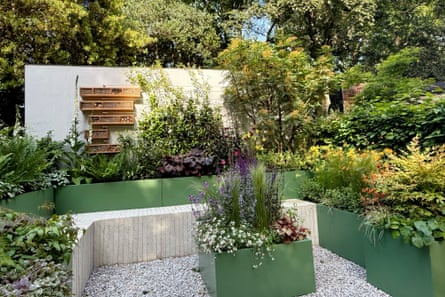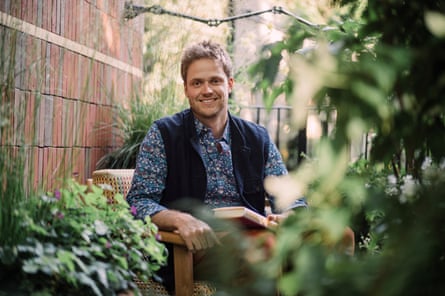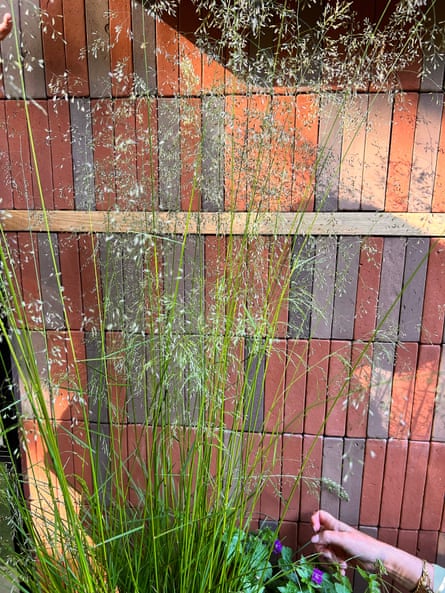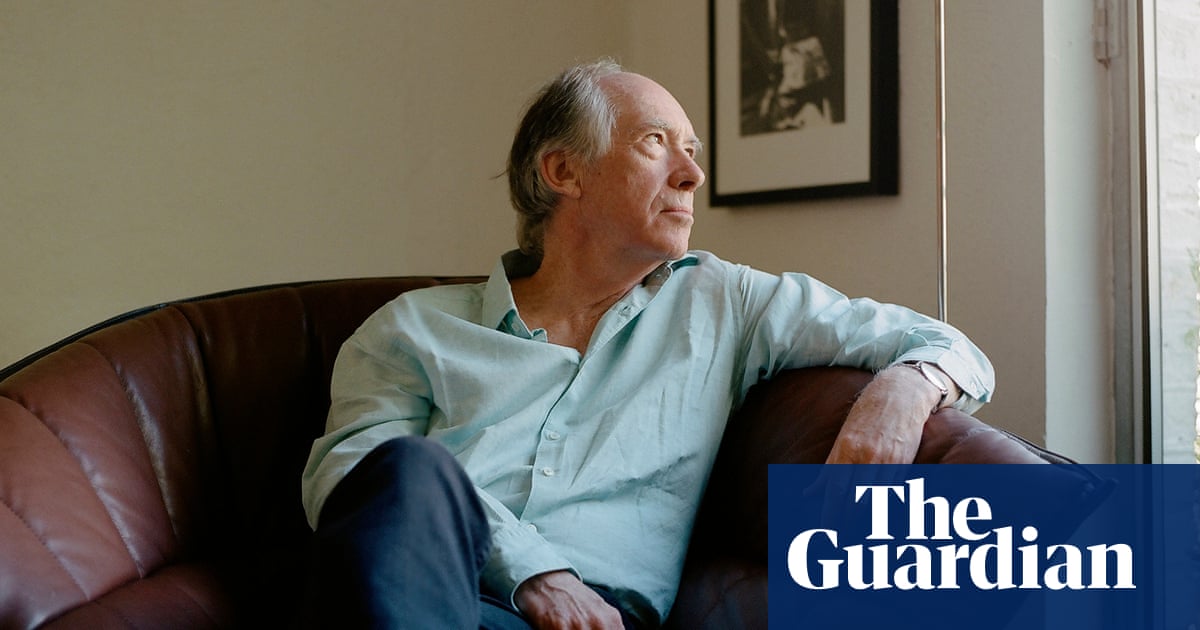The perfectly hewn rocks, babbling brooks and exquisite drifts of flawless flowers of the Chelsea flower show are an out-of-reach dream for anyone without a big-budget sponsor.
But this year, tucked away on a short, shaded stretch away from the elite show gardens, were 10 Chelsea newcomers demonstrating what can be achieved in even the smallest of spaces on balconies and containers.

Silver medal winner and Chelsea debutant Hamzah-Adam Desai doesn’t even have a garden. But in his personal time he has spent years working his green-fingered magic in a communal square in his home in east London.
His “peace of mind” garden at Chelsea impressed the judges with its restful, pared back “restorative” greens to one side through to the purples and pops of yellow and red on the other, in what he describes as a 3D colour wheel.

He trained as a gardener 16 years ago after a bout of seasonal affective disorder but the real education is just doing it. “It’s a constant kind of experimentation”, he says, urging amateurs to learn from their mistakes just as the professionals do.
“I live in a square where we had lots of areas which weren’t gardened so you know we have areas in share where I have my woodland planting and then sunny areas where I have my herbaceous plants.”
One of his top tips for balconies is to “avoid bedding plants”, which he says are less sustainable, only last a year and can be a garden passion killer.
Go for “more shrubby, coastal plants” including heuchera, which “can have very interesting colours”, and grasses that “are brilliant for movement” such as Stipa tenuissima or “wind whispers” with spikes of soft plumes that dance in the gentlest of breezes.
Gardeners should also remember that in urban areas they are likely to be dealing with microclimates.

“Some balconies have glass so when the sun shines the poor plants are being roasted. It is a microclimate; get to know it and what plants work in that environment,” he says.
One of the stars of his garden is an exquisite aquilegia lemon queen, with pale yellow flowers dangling from long spikes. It is a self seeder and was also chosen by his neighbouring designer Ben Strickland and Ben Gifford.
He has also created height – a key to creating privacy and visual variety – by lifting his sage green containers behind his seating area, created through clever vertical stacking of slabs. His are custom-made, but the same effect could be achieved by tiles or slabs taken from an old patio.

Next door to Hamza are gold medal winners Catherine Gibbon and Jen Donnelly, whose part shade garden was inspired by their volunteering at a walled garden at Amersham hospital.
Donnelly’s quickfire top tips for container gardens is to go for the single biggest container you can and use it for multiple plants rather than smaller pots for individual plants which are then prone to drying out. Donnelly advises gardeners to buy one pot for four plants rather than four separate pots.
Choosing the same colour container throughout your small space will tie everything together, another design trick, she says.
Her star tip isrepetition. “Don’t just have one of each plant, have multiples of them and repeat them through the garden.”
“When you go to the garden centre don’t buy 10 different things, buy 10 of the same, or five of two different things. It will immediately transform your garden,” she says.
Another tip shared by all the designers is to place plants with the same watering needs in the one pot. Don’t be tempted to put water loving hydrangea with drought-tolerant lavender, for example.

Designwise, diagonals rather than straight lines can be used to create a sense of space.
“Our space here is only 3 metres by 4 metres but it feels a lot bigger because we have gone for the diagonal,” she says, referring to the planters but also the pergola overhead. “It stretches the space because it draws your eye to the longest line of your garden,” she says.

Her garden is testament to the power of shade loving plants, something vital for the hospital’s east-facing aspect and shade-creating high walls.
Among the most asked about plants is a variety of lady’s mantle – gold strike – and anemone – wild swan – that flower earlier than other Japanese anemones and have purplish reverse petals.
Donnelly and Gibbon’s garden is inspired by their work at Amersham hospital and is designed to help caregivers recharge with a palette of greens and burgundy, creating a harmonious colour scheme by limiting hues to variations within a colour band.

Further down the road, crowds are wowed by Freddie Strickland and Ben Gifford’s “a space to read” balcony garden.
The star of the show is the magnificent Cornus kousa Milky Way, a small tree in the dogwood family.
With their pink and white flower-like bracts they are highly valued in places like Seattle, but are not so common in the UK.
The trees can grow up to 12 metres tall in the ground but in a pot they can be show-stopper addition to a small garden, provided they are not exposed to winds, and are placed in partial sun and neutral to acidic soil.
“This can be pruned minimally once a year. It is a lovely tree, a hard-working tree, with three seasons of interest, the flower which lasts for a month, the fruits and then lovely autumn colour,” says Strickland.
The two designers took a silver gilt medal for their garden dominated by hues of green set off by a wall of vertically placed tiles to mimic a book shelf and two handmade garden chairs.
Strickland’s garden is testament to the less is more philosophy. In 15 containers he has 20 plant types with accents of white, pink and soft yellow including ground cover stars such as the palmate leaved Muckdenia rossii and Epimedium “orangekonigin” with sprays of delicate orange flowers and an evergreen fern, Polypodium vulgare.

Other plants delivering height is a delicate grass, Deschampsia sespitosa, which twinkles in the evening light.
Strickland, who trained in Cornwall, advises those with high rise balconies exposed to windy conditions to walk around their neighbourhood to see what grows well, or to join a local gardening club: “Gardeners love to talk about gardening.”
To survive in containers belonging to people with busy lives, “the plants have to work really hard” so choose those with interest, not the brightest thing in the garden centre, he says.
“It’s really important to encourage people to embrace maintenance as part of the routine, getting your fingers in the soil is a joyous part of living.”
For those without gardens or new to gardening, succulents are a great start, says Jack Drewitt of Surreal Succulents. He advises novices to try anything in the aeonium or echeveria families or an Aloe vera.
“They are ideal for window boxes. People grow them in boots, shoes, just make sure they have a hole for drainage and they are happy in most small spaces and are very easy to propagate,” says Drewitt. Some of the less hardy ones will survive on heating transmitted through glass in the winter and will survive in window boxes.

“They are very forgiving and very accessible and really good for children to start them understanding how plants grow. They are fun,” he added.

 3 months ago
111
3 months ago
111

















































